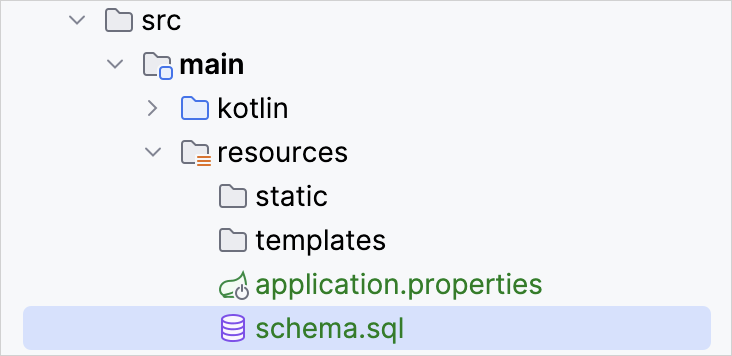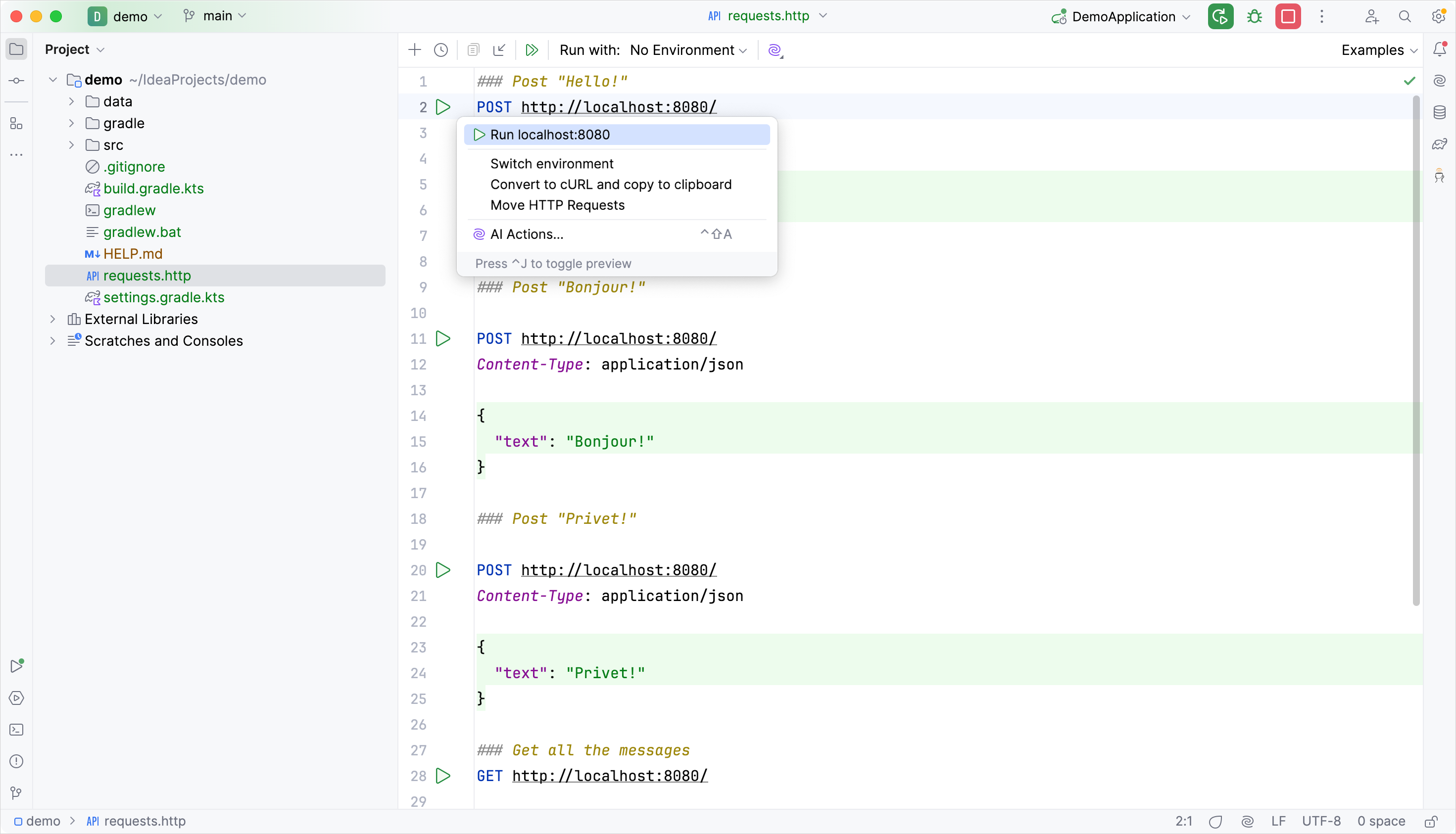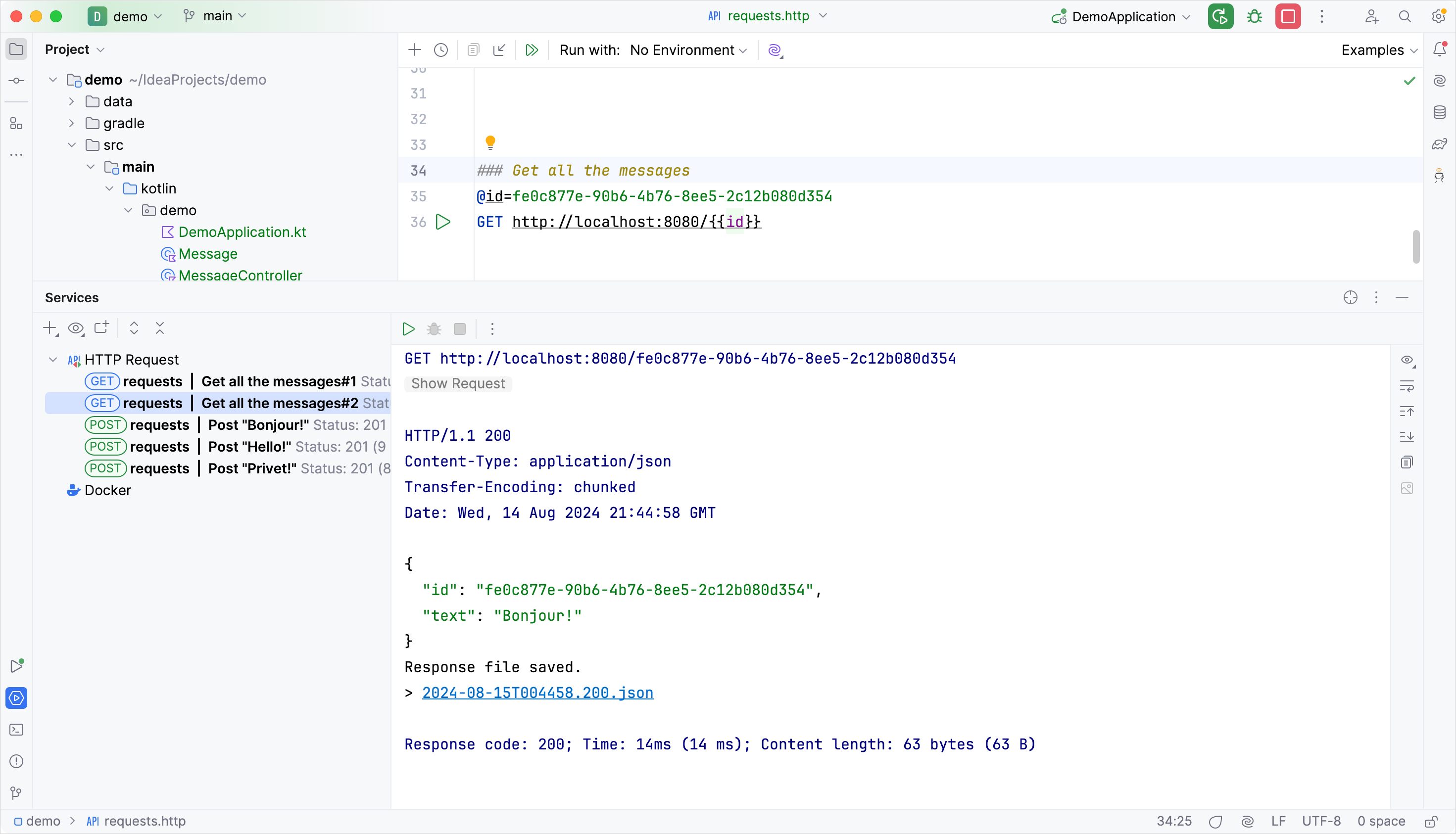為 Spring Boot 專案新增資料庫支援
這是 Spring Boot 和 Kotlin 入門教學的第三部分。在繼續之前,請確保您已完成之前的步驟:
使用 Kotlin 建立 Spring Boot 專案
將資料類別新增至 Spring Boot 專案
為 Spring Boot 專案新增資料庫支援
使用 Spring Data CrudRepository 進行資料庫存取
在本教學的此部分中,您將使用 JDBC 新增資料庫並將其設定到您的專案中。在 JVM 應用程式中,您可以使用 JDBC 與資料庫互動。
為了方便起見,Spring Framework 提供了 JdbcTemplate 類別,可簡化 JDBC 的使用並幫助避免常見錯誤。
新增資料庫支援
在基於 Spring Framework 的應用程式中,常見的做法是在所謂的 服務 (service) 層中實作資料庫存取邏輯 - 這是商業邏輯所在的位置。
在 Spring 中,您應該使用 @Service 註解標記類別,以表示該類別屬於應用程式的服務層。
在本應用程式中,您將為此目的建立 MessageService 類別。
在同一個套件中,建立 MessageService.kt 檔案和 MessageService 類別,如下所示:
// MessageService.kt
package demo
import org.springframework.stereotype.Service
import org.springframework.jdbc.core.JdbcTemplate
import java.util.*
@Service
class MessageService(private val db: JdbcTemplate) {
fun findMessages(): List<Message> = db.query("select * from messages") { response, _ `->`
Message(response.getString("id"), response.getString("text"))
}
fun save(message: Message): Message {
db.update(
"insert into messages values ( ?, ? )",
message.id, message.text
)
return message
}
}
建構子引數和依賴注入 – (private val db: JdbcTemplate)
Kotlin 中的類別具有主要建構子 (primary constructor)。它也可以有一個或多個 次要建構子 (secondary constructors)。
主要建構子 (primary constructor) 是類別標頭的一部分,它位於類別名稱和可選類型參數之後。在我們的例子中,建構子是 (val db: JdbcTemplate)。
val db: JdbcTemplate 是建構子的引數:
@Service
class MessageService(private val db: JdbcTemplate)
尾隨 Lambda (trailing lambda) 和 SAM 轉換 (SAM conversion)
findMessages() 函數呼叫 JdbcTemplate 類別的 query() 函數。query() 函數接受兩個引數:一個作為 String 實例的 SQL 查詢,以及一個回呼 (callback),它將對應每一列的物件:
db.query("...", RowMapper { ... } )
```<br/>
<p>
`RowMapper` 介面只宣告一個方法,因此可以透過省略介面名稱的 Lambda 運算式來實作它。Kotlin 編譯器知道 Lambda 運算式需要轉換成的介面,因為您將其用作函數呼叫的參數。這被稱為 <a href="java-interop#sam-conversions">Kotlin 中的 SAM 轉換 (SAM conversion)</a>:
</p>
```sql
db.query("...", { ... } )
```<br/>
<p>
在 SAM 轉換 (SAM conversion) 之後,查詢函數最終有兩個引數:第一個位置的 String 和最後一個位置的 Lambda 運算式。根據 Kotlin 慣例,如果函數的最後一個參數是一個函數,則可以將作為相應引數傳遞的 Lambda 運算式放置在括號之外。這種語法也稱為 <a href="lambdas#passing-trailing-lambdas">尾隨 Lambda (trailing lambda)</a>:
</p>
```sql
db.query("...") { ... }
未使用 Lambda 引數的底線
對於具有多個參數的 Lambda,您可以使用底線 _ 字元來替換您不使用的參數名稱。
因此,查詢函數呼叫的最終語法如下所示:
db.query("select * from messages") { response, _ `->`
Message(response.getString("id"), response.getString("text"))
}
更新 MessageController 類別
更新 MessageController.kt 以使用新的 MessageService 類別:
// MessageController.kt
package demo
import org.springframework.http.ResponseEntity
import org.springframework.web.bind.annotation.GetMapping
import org.springframework.web.bind.annotation.PostMapping
import org.springframework.web.bind.annotation.RequestBody
import org.springframework.web.bind.annotation.RequestMapping
import org.springframework.web.bind.annotation.RestController
import java.net.URI
@RestController
@RequestMapping("/")
class MessageController(private val service: MessageService) {
@GetMapping
fun listMessages() = service.findMessages()
@PostMapping
fun post(@RequestBody message: Message): ResponseEntity<Message> {
val savedMessage = service.save(message)
return ResponseEntity.created(URI("/${savedMessage.id}")).body(savedMessage)
}
}
@PostMapping 註解
負責處理 HTTP POST 請求的方法需要使用 @PostMapping 註解進行註解。為了能夠將作為 HTTP Body 內容傳送的 JSON 轉換為物件,您需要對方法引數使用 @RequestBody 註解。感謝應用程式類別路徑 (classpath) 中有 Jackson 函式庫,轉換會自動發生。
ResponseEntity
ResponseEntity 表示整個 HTTP 回應:狀態碼、標頭和本文。
使用 created() 方法,您可以設定回應狀態碼 (201) 並設定位置標頭,以指示已建立資源的內容路徑。
更新 MessageService 類別
Message 類別的 id 被宣告為可為空字串 (nullable String):
data class Message(val id: String?, val text: String)
但是,將 null 作為資料庫中的 id 值儲存是不正確的:您需要妥善處理這種情況。
更新 MessageService.kt 檔案的程式碼,以便在將訊息儲存在資料庫中時,當 id 為 null 時產生一個新值:
// MessageService.kt
package demo
import org.springframework.stereotype.Service
import org.springframework.jdbc.core.JdbcTemplate
import org.springframework.jdbc.core.query
import java.util.UUID
@Service
class MessageService(private val db: JdbcTemplate) {
fun findMessages(): List<Message> = db.query("select * from messages") { response, _ `->`
Message(response.getString("id"), response.getString("text"))
}
fun save(message: Message): Message {
val id = message.id ?: UUID.randomUUID().toString() // Generate new id if it is null
db.update(
"insert into messages values ( ?, ? )",
id, message.text
)
return message.copy(id = id) // Return a copy of the message with the new id
}
}
Elvis 運算子 – ?:
程式碼 message.id ?: UUID.randomUUID().toString() 使用 Elvis 運算子(非空值則返回,否則簡寫) ?:。如果 ?: 左側的運算式不是 null,則 Elvis 運算子會傳回它;否則,它會傳回右側的運算式。請注意,只有當左側為 null 時,才會評估右側的運算式。
應用程式程式碼已準備好與資料庫一起使用。現在需要設定資料來源。
設定資料庫
在應用程式中設定資料庫:
-
在
src/main/resources目錄中建立schema.sql檔案。它將儲存資料庫物件定義:
-
使用以下程式碼更新
src/main/resources/schema.sql檔案:-- schema.sql
CREATE TABLE IF NOT EXISTS messages (
id VARCHAR(60) PRIMARY KEY,
text VARCHAR NOT NULL
);它會建立具有兩欄的
messages資料表:id和text。資料表結構與Message類別的結構相符。 -
開啟位於
src/main/resources資料夾中的application.properties檔案,並新增以下應用程式屬性:spring.application.name=demo
spring.datasource.driver-class-name=org.h2.Driver
spring.datasource.url=jdbc:h2:file:./data/testdb
spring.datasource.username=name
spring.datasource.password=password
spring.sql.init.schema-locations=classpath:schema.sql
spring.sql.init.mode=always這些設定會為 Spring Boot 應用程式啟用資料庫。
請參閱 Spring 文件 中的常見應用程式屬性完整清單。
透過 HTTP 請求將訊息新增至資料庫
您應該使用 HTTP 用戶端來使用先前建立的端點。在 IntelliJ IDEA 中,使用內嵌的 HTTP 用戶端:
-
執行應用程式。應用程式啟動並執行後,您可以執行 POST 請求以將訊息儲存在資料庫中。
-
在專案根資料夾中建立
requests.http檔案,並新增以下 HTTP 請求:### Post "Hello!"
POST http://localhost:8080/
Content-Type: application/json
{
"text": "Hello!"
}
### Post "Bonjour!"
POST http://localhost:8080/
Content-Type: application/json
{
"text": "Bonjour!"
}
### Post "Privet!"
POST http://localhost:8080/
Content-Type: application/json
{
"text": "Privet!"
}
### Get all the messages
GET http://localhost:8080/ -
執行所有 POST 請求。使用請求宣告旁邊溝槽中的綠色 執行 (Run) 圖示。 這些請求會將文字訊息寫入資料庫:

-
執行 GET 請求,並在 執行 (Run) 工具視窗中查看結果:

執行請求的替代方法
您也可以使用任何其他 HTTP 用戶端或 cURL 命令列工具。例如,在 終端機中執行以下命令以獲得相同的結果:
curl -X POST --location "http://localhost:8080" -H "Content-Type: application/json" -d "{ \"text\": \"Hello!\" }"
curl -X POST --location "http://localhost:8080" -H "Content-Type: application/json" -d "{ \"text\": \"Bonjour!\" }"
curl -X POST --location "http://localhost:8080" -H "Content-Type: application/json" -d "{ \"text\": \"Privet!\" }"
curl -X GET --location "http://localhost:8080"
依 ID 檢索訊息
擴充應用程式的功能以依 ID 檢索個別訊息。
-
在
MessageService類別中,新增新函數findMessageById(id: String)以依 ID 檢索個別訊息:// MessageService.kt
package demo
import org.springframework.stereotype.Service
import org.springframework.jdbc.core.JdbcTemplate
import org.springframework.jdbc.core.query
import java.util.*
@Service
class MessageService(private val db: JdbcTemplate) {
fun findMessages(): List<Message> = db.query("select * from messages") { response, _ `->`
Message(response.getString("id"), response.getString("text"))
}
fun findMessageById(id: String): Message? = db.query("select * from messages where id = ?", id) { response, _ `->`
Message(response.getString("id"), response.getString("text"))
}.singleOrNull()
fun save(message: Message): Message {
val id = message.id ?: UUID.randomUUID().toString() // Generate new id if it is null
db.update(
"insert into messages values ( ?, ? )",
id, message.text
)
return message.copy(id = id) // Return a copy of the message with the new id
}
}用於依 ID 提取訊息的
.query()函數是由 Spring Framework 提供的 Kotlin 擴充函數。 它需要額外的匯入import org.springframework.jdbc.core.query,如上面的程式碼所示。 -
將具有
id參數的新index(...)函數新增至MessageController類別:// MessageController.kt
package demo
import org.springframework.http.ResponseEntity
import org.springframework.web.bind.annotation.GetMapping
import org.springframework.web.bind.annotation.PathVariable
import org.springframework.web.bind.annotation.PostMapping
import org.springframework.web.bind.annotation.RequestBody
import org.springframework.web.bind.annotation.RequestMapping
import org.springframework.web.bind.annotation.RestController
import java.net.URI
@RestController
@RequestMapping("/")
class MessageController(private val service: MessageService) {
@GetMapping
fun listMessages() = ResponseEntity.ok(service.findMessages())
@PostMapping
fun post(@RequestBody message: Message): ResponseEntity<Message> {
val savedMessage = service.save(message)
return ResponseEntity.created(URI("/${savedMessage.id}")).body(savedMessage)
}
@GetMapping("/{id}")
fun getMessage(@PathVariable id: String): ResponseEntity<Message> =
service.findMessageById(id).toResponseEntity()
private fun Message?.toResponseEntity(): ResponseEntity<Message> =
// If the message is null (not found), set response code to 404
this?.let { ResponseEntity.ok(it) } ?: ResponseEntity.notFound().build()
}
從內容路徑檢索值
訊息 id 是由 Spring Framework 從內容路徑檢索的,因為您使用 @GetMapping("/{id}") 註解對新函數進行註解。透過使用 @PathVariable 註解函數引數,您可以告訴 Framework 使用檢索到的值作為函數引數。新函數會呼叫 MessageService 以依 ID 檢索個別訊息。
參數清單中 vararg 引數的位置
query() 函數採用三個引數:
id,它是 String 類型的參數RowMapper 實例由 Lambda 運算式實作query() 函數的第二個參數宣告為可變引數 (vararg)。在 Kotlin 中,可變引數參數的位置不一定要是參數清單中的最後一個。
具有可為空接收者的擴充函數
可以使用可為空接收者類型來定義擴充。如果接收者是 null,則 this 也是 null。因此,在定義具有可為空接收者類型的擴充時,建議在函數主體內執行 this == null 檢查。
您也可以使用安全呼叫運算子 (safe invocation operator) (?.) 來執行空值檢查,如上面的 toResponseBody 函數中所示:
this?.let { ResponseEntity.ok(it) }
ResponseEntity
ResponseEntity 表示 HTTP 回應,包括狀態碼、標頭和本文。它是一個泛型包裝函式,可讓您將自訂的 HTTP 回應傳送回用戶端,並更好地控制內容。
以下是應用程式的完整程式碼:
// DemoApplication.kt
package demo
import org.springframework.boot.autoconfigure.SpringBootApplication
import org.springframework.boot.runApplication
@SpringBootApplication
class DemoApplication
fun main(args: Array<String>) {
runApplication<DemoApplication>(*args)
}
// Message.kt
package demo
data class Message(val id: String?, val text: String)
// MessageService.kt
package demo
import org.springframework.stereotype.Service
import org.springframework.jdbc.core.JdbcTemplate
import org.springframework.jdbc.core.query
import java.util.*
@Service
class MessageService(private val db: JdbcTemplate) {
fun findMessages(): List<Message> = db.query("select * from messages") { response, _ `->`
Message(response.getString("id"), response.getString("text"))
}
fun findMessageById(id: String): Message? = db.query("select * from messages where id = ?", id) { response, _ `->`
Message(response.getString("id"), response.getString("text"))
}.singleOrNull()
fun save(message: Message): Message {
val id = message.id ?: UUID.randomUUID().toString()
db.update(
"insert into messages values ( ?, ? )",
id, message.text
)
return message.copy(id = id)
}
}
// MessageController.kt
package demo
import org.springframework.http.ResponseEntity
import org.springframework.web.bind.annotation.GetMapping
import org.springframework.web.bind.annotation.PathVariable
import org.springframework.web.bind.annotation.PostMapping
import org.springframework.web.bind.annotation.RequestBody
import org.springframework.web.bind.annotation.RequestMapping
import org.springframework.web.bind.annotation.RestController
import java.net.URI
@RestController
@RequestMapping("/")
class MessageController(private val service: MessageService) {
@GetMapping
fun listMessages() = ResponseEntity.ok(service.findMessages())
@PostMapping
fun post(@RequestBody message: Message): ResponseEntity<Message> {
val savedMessage = service.save(message)
return ResponseEntity.created(URI("/${savedMessage.id}")).body(savedMessage)
}
@GetMapping("/{id}")
fun getMessage(@PathVariable id: String): ResponseEntity<Message> =
service.findMessageById(id).toResponseEntity()
private fun Message?.toResponseEntity(): ResponseEntity<Message> =
this?.let { ResponseEntity.ok(it) } ?: ResponseEntity.notFound().build()
}
執行應用程式
Spring 應用程式已準備好執行:
-
再次執行應用程式。
-
開啟
requests.http檔案並新增新的 GET 請求:### Get the message by its id
GET http://localhost:8080/id -
執行 GET 請求以從資料庫檢索所有訊息。
-
在 執行 (Run) 工具視窗中,複製其中一個 ID 並將其新增至請求,如下所示:
### Get the message by its id
GET http://localhost:8080/f16c1d2e-08dc-455c-abfe-68440229b84f請將您的訊息 ID 放入上面提到的位置,而不是上面提及的內容。
-
執行 GET 請求,並在 執行 (Run) 工具視窗中查看結果:

下一步
最後一個步驟將向您展示如何使用 Spring Data 更常見的資料庫連線。